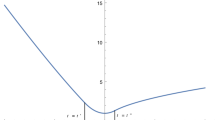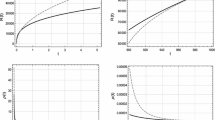Abstract
We present the cosmological model of a bouncing universe with causal fluid in the universe. The dissipative effects of the causal cosmic fluid is probed with both truncated Israel–Stewart theory and full Israel–Stewart theory. The following classes of non-vanishing scale factors of bouncing cosmology are considered with a viscous fluid: (i) the power-law bouncing model, (ii) the exponential bouncing model and (iii) the matter bouncing model in the Einstein gravity. The cosmological parameters of the Hubble parameter, deceleration parameter, jerk parameter, energy density and bulk viscous pressure of the universe are determined in the theories to obtain realistic cosmologies. The observational constraints of the parameters of bouncing cosmological models are estimated making use of the observed cosmological data. The physical and geometrical aspects of the cosmological models based on the imposed constraints are also discussed.









Similar content being viewed by others
References
Ade, P.A.R., et al.: Astron. Astrophys. 594, A20 (2016)
Akarsu, O., Kumar, S., Myrzakulov, R., Sami, M., Xu, L.: J. Cosmol. Astropart. Phys. 01, 022 (2014)
Ashtekar, A., Singh, P.: Class. Quantum Gravity 28, 21301 (2011)
Bamba, K., Odintsov, S.D.: Symmetry 7, 220 (2015)
Bamba, K., Makarenko, A.N., Myagky, A.N., Nojiri, S., Odintsov, S.D.: J. Cosmol. Astropart. Phys. 01, 008 (2004)
Bamba, K., Makaenko, A.N., Myagky, A.N., Odintsov, S.D.: Phys. Rev. B 732, 349 (2014a)
Bamba, K., Makarenko, A.N., Myagky, A.N., Nojiri, S., Odintsov, S.D.: J. Cosmol. Astropart. Phys. 1401, 008 (2014b)
Bamba, K., Nojiri, S., Odintsov, S.D., Sáez-Gómez, D.: Phys. Rev. D 90, 124061 (2014c)
Bamba, K., Nashed, G.G.L., Hanafy, W.E., Ibraheem, S.K.: Phys. Rev. D 94, 083513 (2016)
Barrow, J.D., Matzner, R.A.: Mon. Not. R. Astron. Soc. 181, 719 (1977)
Battefeld, D., Peter, P.: Phys. Rep. 571, 1 (2015)
Brandenberger, R.: Phys. Rev. D 80, 043516 (2009a)
Brandenberger, R.: Phys. Rev. D 80, 023535 (2009b)
Brandenberger, R.H.:. arXiv:1206.4196
Brevik, I., Gorbunova, O.: Eur. Phys. J. C 56, 425 (2008)
Brevik, I., Timoshkin, A.V.: Int. J. Geom. Methods Mod. Phys. 17, 2050023 (2020)
Brevik, I., Elizalde, E., Odintsov, S.D., Timoshkin, A.V.: Int. J. Geom. Methods Mod. Phys. 14, 1750185 (2017)
Cai, Y-F., Wilson-Ewing, E.: J. Cosmol. Astropart. Phys. 03, 026 (2014)
Cai, Y.-F., Brandenberger, R., Zhang, X.: J. Cosmol. Astropart. Phys. 2011, 03 (2011)
Cai, Y.-F., Chen, S.-H., Dent, J.B., Dutta, S., Saridakis, E.N.: Class. Quantum Gravity 28, 215011 (2011)
Cai, Y.-F., Easson, D.A., Brandenberger, R.H.: J. Cosmol. Astropart. Phys. 1208, 020 (2012)
Capozziello, S., De Laurentis, M.: Phys. Rep. 509, 167 (2011)
Chakraborty, S., Mazumder, N., Biswas, R.: Astrophys. Space Sci. 334, 183 (2011)
Cruz, M., Cruz, N., Lepe, S.: Phys. Rev. D 96, 124020 (2017)
Debnath, P.S.: Int. J. Geom. Methods Mod. Phys. 16, 1950005 (2019)
Debnath, P.S.: Int. J. Mod. Phys. A 35, 2050173 (2020a)
Debnath, P.S.: Mod. Phys. Lett. A 35, 2050216 (2020b)
Debnath, P.S., Paul, B.C.: Mod. Phys. Lett. A 32, 1750216 (2017)
Debnath, P.S., Paul, B.C.: Int. J. Geom. Methods Mod. Phys. 17, 2050102 (2020)
Debnath, U., Schakraborty, S.: Int. J. Theor. Phys. 50, 2892 (2011)
Debnath, P.S., Beesham, A., Paul, B.C.: Class. Quantum Gravity 35, 115010 (2018)
Eckart, C.: Phys. Rev. D 58, 269 (1940)
Elizalde, E., Haro, J., Odintsov, S.D.: Phys. Rev. D 91, 063522 (2015)
Elizalde, E., Odintsov, S.D., Oikonomou, V.K., Paul, T.: Nucl. Phys. B 954, 114984 (2020)
Femaro, R., Fiorini, F.: Phys. Rev. D 75, 084031 (2007)
Goswami, G.K., Pradhan, A., Mishra, M., Beesham, A.: New Astron. 73, 101284 (2019)
Guth, A.: Phys. Rev. D 23, 347 (1981)
Haro, J.d, Amoros, J.: J. Cosmol. Astropart. Phys. 12, 031 (2014)
Israel, W., Stewart, J.M.: Ann. Phys. 118, 341 (1979)
Jou, D., Vazquez, J.C., Lebon, G.: Extended Irreversible Thermodynamics. Springer, New York (2010)
Malsawmtluangi, N., Suresh, P.K.: Eur. Phys. J. C 76, 240 (2016)
Misner, C.W.: The isotropy of the universe. Astrophys. J. 151, 431 (1968)
Molla, S., Ghosh, B., Kalam, M.: Eur. Phys. J. Plus 135, 362 (2020)
Mukherjee, S., Paul, B.C., Dadhich, N.K., Maharaj, S.D., Beesham, A.: Class. Quantum Gravity 23, 6927 (2006)
Myrzakulov, R., Sebatiani, L.: Astrophys. Space Sci. 352, 281 (2014)
Nagpal, R., Singh, J.K., Aygun, S.: Astrophys. Space Sci. 363, 114 (2018)
Nojiri, S., Odintsov, S.D.: Phys. Rev. D 72, 023003 (2005)
Nojiri, S., Odintsov, S.D.: Phys. Lett. B 639, 144 (2006)
Nojiri, S., Odintsov, S.D.: Phys. Rep. 505, 59 (2011)
Nojiri, S., Odintsov, S.D., Tsujikawa, S.: Phys. Rev. D 71, 063004 (2005)
Nojiri, S., Odintsov, S.D., Tretyakov, P.V.: Prog. Theor. Phys. Suppl. 172, 81 (2008)
Nojiri, S., Odintsov, S.D., Oikonomou, V.K., Paul, T.: Phys. Rev. D 100, 084056 (2019)
Odintsov, S.D., Oikonomou, V.K.: Phys. Rev. D 91, 064036 (2015)
Odintsov, S.D., Oikonomou, V.K., Saridaki, E.N.: Ann. Phys. 359, 30 (2015)
Oikonomou, V.K.: Astrophys. Space Sci. 359, 30 (2015)
Padmanabhan, T.: Phys. Rep. 380, 235 (2003)
Paul, B.C.: Phys. Rev. D 64, 027302 (2001)
Paul, B.C., Mukherjee, S., Beesham, A.: Int. J. Mod. Phys. D 7, 499 (1998a)
Paul, B.C., Mukherjee, S., Beesham, A.: Int. J. Mod. Phys. D 7, 567 (1998b)
Paul, B.C., Mukherjee, S., Beesham, A.: NBU Sci. Technol. Rev. 10, 44 (1999)
Pavon, D., Zimdhal, W.: Phys. Lett. A 179, 261 (1993)
Pavon, D., Bafaluy, J.B., Jou, D.: Class. Quantum Gravity 8, 347 (1991)
Riess, A.G., et al.: Astrophys. J. 116, 1009 (1998)
Riess, A.G., et al.: Astrophys. J. 607, 665 (2004)
Sahoo, P.K., Tripathy, S.K., Sahoo, P.: Mod. Phys. Lett. A 33, 1850193 (2018)
Sahoo, P., Bhattacharjee, S., Tripathy, S.K., Sahoo, P.K.: Mod. Phys. Lett. A 35, 2050095 (2020)
Singh, J.K., Bamba, K., Nagpal, R., Pacif, S.K.J.:. arXiv:1807.01157
Starobinskii, A.A.: Pis’ma Zh. Eksp. Teor. Fiz. 30, 719 (1979a)
Starobinsky, A.A.: JETP Lett. 30, 682 (1979b)
Starobinsky, A.A.: Phys. Lett. B 91, 99 (1980)
Swastik, C., Suresh, P.K., Maity, B.: Rep. Adv. Phys. Sci. 4, 20500012 (2020)
Wan, Y., Qui, T., Huang, F.P., Cai, Y-F., Li, H., Zhang, X.: JACP 12, 019 (2015)
Zimdahl, W., Schwarz, D.J., Balakin, A.B., Pavon, D.: Phys. Rev. D 64, 063501 (2001)
Acknowledgement
The authors acknowledge their gratitude to IUCAA, Pune and IRC, NBU for widening the essential research amenities to begin the work. The authors would also like to thank the anonymous reviewers for their important productive remarks to improve the paper.
Author information
Authors and Affiliations
Corresponding author
Additional information
Publisher’s Note
Springer Nature remains neutral with regard to jurisdictional claims in published maps and institutional affiliations.
Appendix A: Appendix material
Appendix A: Appendix material
The expressions corresponding to the parameters \(C_{1}\), \(C_{2}\) and \(C_{3}\) used in Eq. (8), (13) and (24) are given as follows:
and
Rights and permissions
About this article
Cite this article
Debnath, P.S., Paul, B.C. Bouncing scenario with causal cosmology. Astrophys Space Sci 366, 32 (2021). https://doi.org/10.1007/s10509-021-03937-3
Received:
Accepted:
Published:
DOI: https://doi.org/10.1007/s10509-021-03937-3




